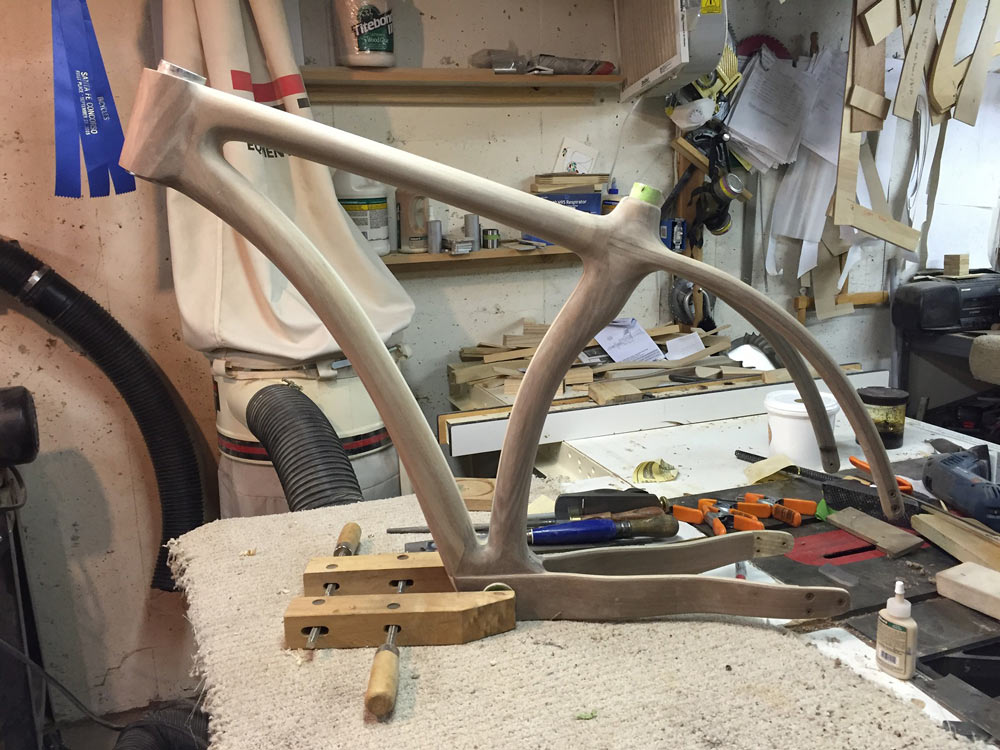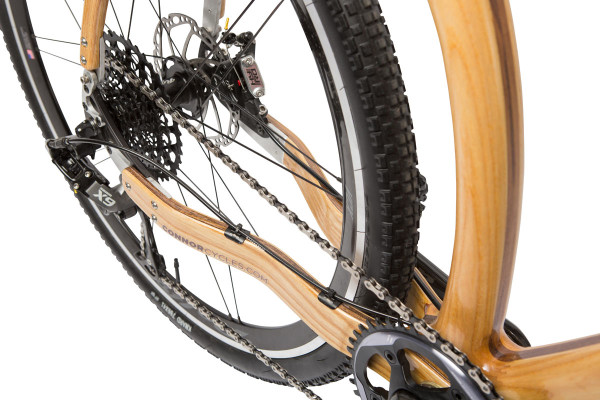
I sought out Chris Connor for a phone interview in this series primarily because of a bike he did for NAHBS last year, a white ash bike he made in conjunction with Louisville Slugger in honor of the show location. I’ll admit – I hadn’t sought out or worked to understand wood as a modern bicycle frame material until learning about this bike but when presented with the baseball bat analogy for impact resistance, I reconsidered the medium for the application.
Chris is exceptional not just for his choice of material but also for his approach in embracing the performance reinforcements and adhesives that have been developed as a result of the refreshed interest in sustainability and renewable materials. His bikes are highly labor intensive – but Chris believes it is entirely worth it for the unique suppleness and beauty of the final product…
BIKERUMOR: I was stoked to put you on the phone interview list for this series because there aren’t very many wood frame builders out there, and your repertoire is much bigger than bikes. What is your story of how you got into frame building?
CHRIS: My story comes at bicycles from a slightly different angle. Of course, I think that anybody who finds themselves professionally dealing with bikes had an early on passion with them in some capacity, rode them as kids. I’ve always had that love for cycling. Riding through growing up. After school, I got out of college, worked in various high technology fields in Boulder for a bunch of years, but was always sort of a closet tinkerer. I love to just take stuff apart and build things, and hot rod stuff.
BIKERUMOR: What sort of degree? What area you were working in?
CHRIS: I have a degree in Psychology and Political Science. This was sort of late 90’s, early 2000’s – I found myself in the emerging new media field. I worked for a couple of companies that did writing, producing videos. Then video started moving to the web so I started working with interactive technologies, so I started designing websites, including interactive content, whether that a was video or flash-based presentation on the web. Then I started working at an agency in Boulder, Colorado where I was working on interactive marketing campaigns for big companies like IBM and stuff like that. I was doing interactive presentations, different types of interactive new media content for these companies.
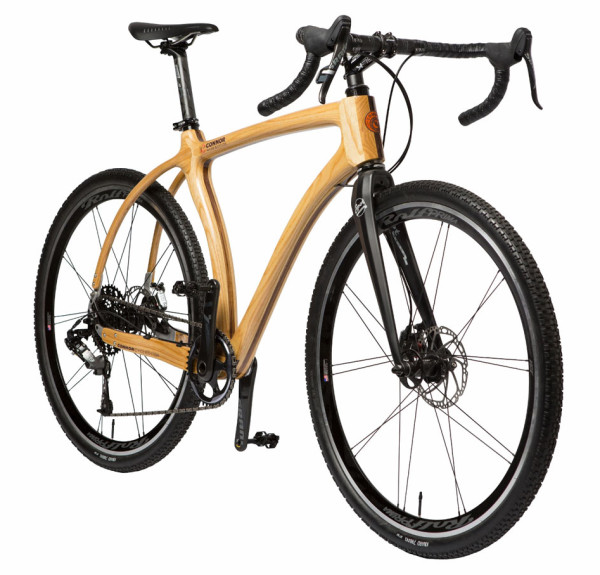
BIKERUMOR: So entirely intangible stuff.
CHRIS: Precisely. Yes! It was pixels and bytes. You work for months on a campaign, you put your heart into this stuff, and it would launch out on the web, and there would be a big initial splash. Six weeks later, it would be gone. Nothing remaining. I liked what I was doing, I loved the constant challenges of this emerging technology. I loved the challenge of working with major clients and all this other fun stuff, but it was draining. You would throw yourself into this, and things would just vaporize.
So on the weekends and at night I would go and work in my garage. I would rebuild the transmission in my car, rebuild the engine in old sports cars and stuff like that, and I would ride my bike and do upgrades to my bike and try to make it lighter and faster and all that good stuff. So I was trying to figure out what I really wanted to do with myself next. I started building some skills in woodworking, which I had always tinkered with as a kid. I built furniture and designed and built loud speakers because I liked the mix of technology and functionality.
BIKERUMOR: Huh, I never thought about that that way.
CHRIS: Yeah, it was my take on things. It’s been a recurring theme through my design career is enjoying things that are beautiful and functional. I love working on loudspeakers and furniture, something that had a functional component to it. Chairs that have a very ergonomic essence to them. They have to be comfortable. And they have to be beautiful. So I built chairs and all these things on my spare time.
Meanwhile in sort of a parallel path, my brother had been starting a business building classical acoustic guitars. He came out of school as a music major, played guitar, really loved the amazing qualities of a hand built guitar. So he started doing that and managed to get a bunch of old great performers and players working on his instruments and got himself in a place where he had a huge backlog of orders and needed some help. He and I had a great relationship and he asked me, “Would you come out and work with me for awhile.”
I said, “Sure. Heck yeah.”
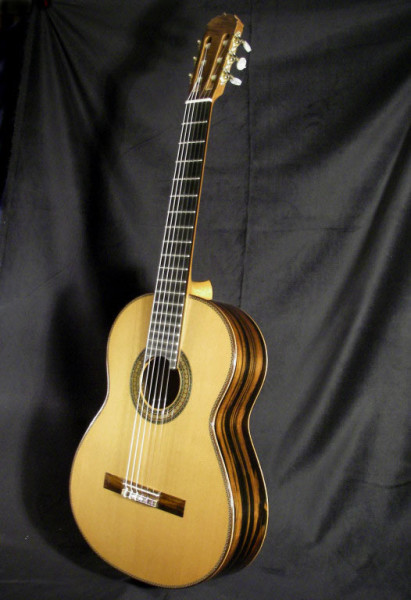
It wasn’t quite as easy as heck yeah. At this point, I had two little kids. My wife and I both had great jobs in Boulder. And he was on the East Coast, which is where I grew up. But nonetheless, we sold our house, we quit our jobs, we moved across the country and I starting building guitars with him. It was great because I was working for myself. We were working really together as the two owners of the business. I was able to come in and bring a lot of the high tech marketing communication and sort of business and accounting skills that I had developed in the professional world for a bunch of years. We were able to streamline his communications and overhaul his website, straighten out how he organized his projects and put in place an accounting system. And then we looked at the guitar building process – I’ve always loved process, how you do things. I was able to come into it with a clean slate. I haven’t come into this originally as a guitar builder but what’s taking time? Where can we do things more efficiently? Where can we put in specialized machinery and jigs and fixtures? How can we make this process go faster? Where are we spending a lot of time?
We were able to manufacture these guitars more efficiently. He was able to really streamline his building process. We were able to sell more efficiently because we had better articulation of what different models were and how they were priced and why they were priced, so it made a huge difference in his business. I just missed the West, for as much fun as I was having. Where we were on the east coast just wasn’t conducive to raising a family.
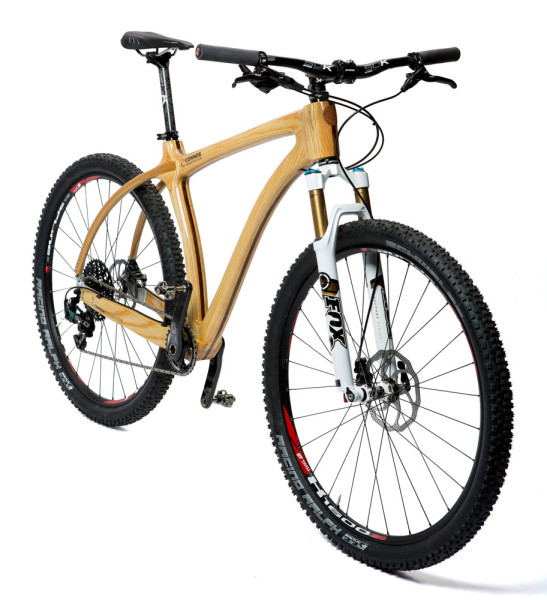
BIKERUMOR: And it’s not cheap.
CHRIS: No it’s not cheap. And it s a very different lifestyle. So we said “I guess we’re going to move back to Colorado.” My wife got a great job back in Denver, so we moved as a family back to Denver. I scratched my head for a little bit. What do I want to do with myself? I really love working with myself, working with my hands, creating things that are beautiful and functional and not transient like the pixel world I had come out of. I wondered for awhile what I was going to do. I really wanted to continue to work for myself and make things that were beautiful and functional. I thought about – I don’t want to have a competing guitar business because that’s not something I’m trying to do. I Love guitars, but my brother’s really got a fantastic thing going there, I didn’t want to start a “Connor Guitars II” or something like that.
BIKERUMOR: “Also Connor Guitars.”
CHRIS: “The Other Connor Guitars.” No, that wouldn’t work. And further more, I don’t even play guitar.
BIKERUMOR: It would be like a bike builder that doesn’t ride bikes. There aren’t too many of those.
CHRIS: You can’t even ride a bicycle, you get on it and just fall right off, that’s how I am with a guitar. So I was trying to figure out what it was that I wanted to do. My wife’s a big rider. I love to ride whenever I can – it’s always been something I love doing.
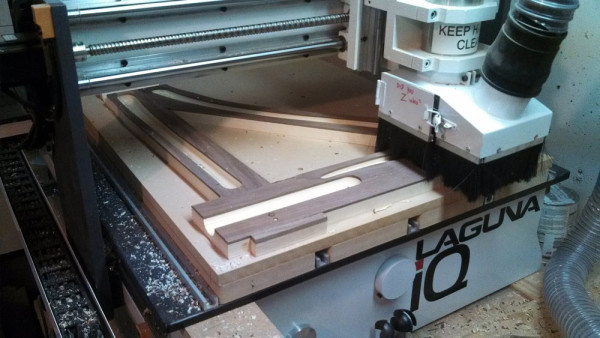
So I had this crazy idea one night, and I don’t know what really inspired it, but I think I had had a couple beers, “Well maybe I should build a plywood bike for my wife. Something I could build out of wood. She’s like do it. It’d be good fun.”
I realized the madness in this. What a stupid idea! It’s crazy. The idea of building a semi-disposable plywood bike. Why would I waste my time on something like that?
I discarded the idea, but a few days later I came back to it. I thought, “Wait a minute, wait a minute, wait a minute, what’s so crazy about this? The crazy part of this is doing it as a joke, doing it as something that’s disposable.”
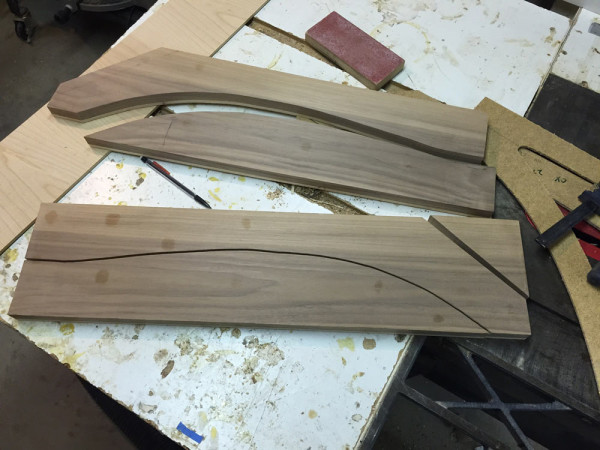
BIKERUMOR: That’s a lot of work for something disposable.
CHRIS: Yeah, for something that would be just kind of a whim project. Well, wait a minute. Why don’t I come at this like this? I have skills in designing furniture, things that are beautiful, have flowing curves, use wood in a beautiful way. I worked with the guitars – you have to have absolute precision in your neck angles and things like that. That has to relate to precise geometry in a bicycle as well.
When I was doing the guitars, we worked with some composite materials for reinforcing guitars. We also explored a carbon fiber guitar case company, we worked with a company to try to produce that for us, it never really got anywhere, but at the same time, I’d built a lot of knowledge on how different composite materials worked and their properties and how you work with them. When I was living on the East Coast we lived on the water, I spent a lot of time at the water. We messed around designing and building simple boats, but things that had to be durable and take a beating and be outside.
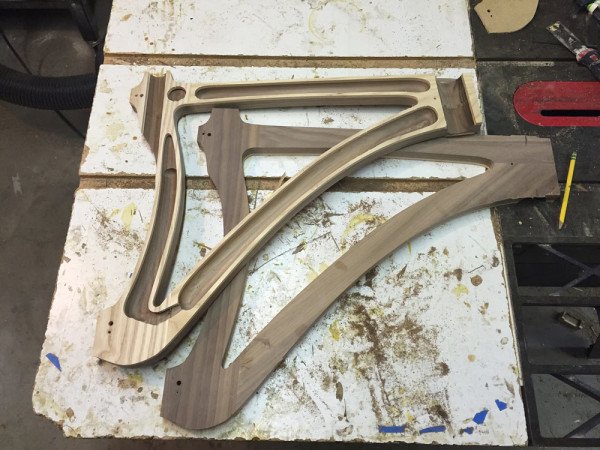
I said, “Well wait a minute, I have all these skills making things that are functional, beautiful, precise – this is the exact required skill set that it would take to build a really bad ass wood bicycle.” Something that wasn’t a joke. Something that was precise and strong and could be ridden outside and treated every bit as a bicycle.
BIKERUMOR: Had you seen or were you aware of or following any existing serious wood bike builders at the time? Because I’ll admit that I’m ignorant when it comes to this material and bikes.
CHRIS: There were very few – I wasn’t aware of anybody. But I was also so naive to think that any good idea hadn’t already been thought of. So I went out and did some competitive research. I looked around, and this was four plus years ago at this point, and there’s really nothing out there. There’s one company on the west coast doing it, there was a company in Germany that was doing it, and there were a couple really weird projects that people had put out there, things that were really just avant garde and highly impractical.
BIKERUMOR: One-off project stuff.
CHRIS: Yeah, I looked at it and I said, “The people that are out there doing it, there’s very very few of them. I see absolute room for improvement. I think I can make something that’s more beautiful, that’s stronger, that’s more functional, and that would just be in my opinion just a better bicycle.”
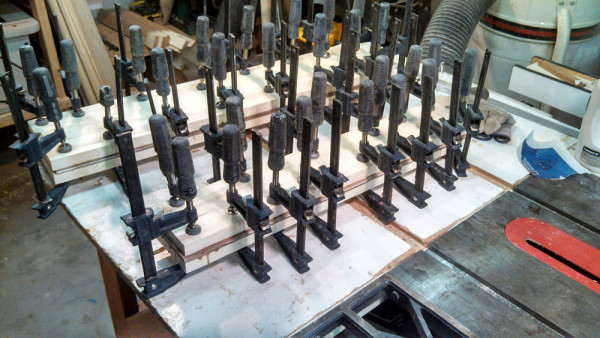
BIKERUMOR: Why did you think you could do this? Why were you the person to figure this out?
CHRIS: Well, other people had done this, so I realized that it had to be possible. If I could go about this, I’ve been bending wood, making things that are strong, that are reinforced. No one else was doing steam bending in their designs, no one else was doing composite reinforcement. No one else was integrating any other composite material. I don’t think anyone else is today, I don’t think anyone else is doing it yet. While I think that wood alone is exceptionally strong, if you want to get performance out of it, the great ride quality that I think it delivers, composites can take you a long way of guaranteeing additional strength and giving it that bulletproof edge if you’re going to be creating something that’s really going to be a performance art. It has to be beautiful and it has to be functional… so it’d better well not break on you.
BIKERUMOR: Well, wood is the original composite material in cycling.
CHRIS: It is! It was used in wood rims. It is far more durable and strong than people give it credit for. In particular with the latest advances, technology has also made it much easier for us to work with the material, making things that are exceptionally strong and durable out of wood. There are incredible adhesives now, and that’s one of the things I’ve done a lot of research in is working with the right adhesives. Some of the new amazing elasticized epoxies and things like that really let you work with wood in a way that was really never possible before. So even while early aircraft propellers were made out of wood with animal hide glue, they were doing absolutely mission critical things – if your propeller flies apart, your aircraft comes down in a hurry. People have been using wood in mission critical applications for a long time.
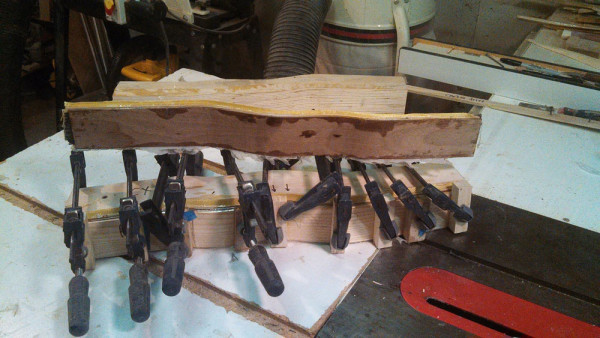
Now, you can use advanced composites in there, advanced adhesives in there, use the right design and the right assembly and manufacturing techniques, and you get something that’s incredibly durable, incredibly strong and beautiful. And I don’t know that I really knew that I could figure it out when I first started thinking about it, but I had a pretty good idea that if it could be done. I could figure out a way to do it and to do it right.
Yeah. And maybe that’s a little bit of blind optimism.
BIKERUMOR: You started looking into this about four years ago. How many of these bikes have you made?
CHRIS: It’s not that many still, but it feels like it’s a very familiar process now. It’s probably anywhere between 30 and 40 bikes.
BIKERUMOR: Any sort of composites process where you’re actually making the material in addition to the structure? – it’s a much more laborious path.
CHRIS: It is. Yeah, it is laborious path. What’s fun about it is that there are so many different steps to it. There’s lamination. You’re preparing all these materials. But after you get things together in this sort of rough form, there is this great sculptural process to it. I’ve got some automated procedures that help me build the main triangle. I’m laminating my chainstays and my seatstays. A lot of the shaping at the end is all done by hand. Your general shapes are done in your molds and templates, but I’m sitting here smoothing out some of the joints with a rasp, then goes to a file, then goes to sandpaper. Each one of these has a slightly different shape to it.
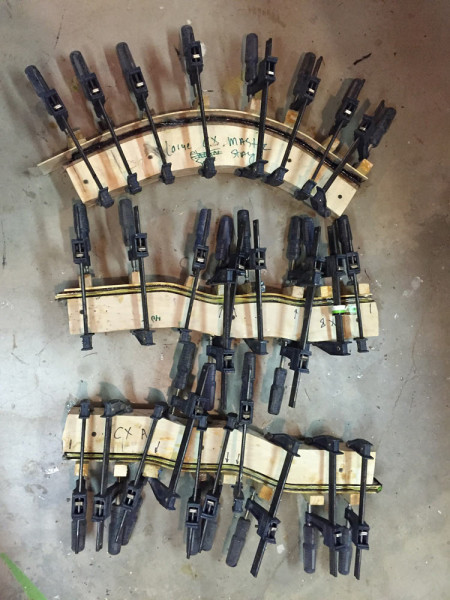
The fact that you’re doing this very, I don’t know, precision hand-shaping to your bike gives it this great sculptural quality to it, and that’s one of the areas that wood really differentiates itself from other materials. Wood has this very sort of sculptural aesthetic to it. The way things smooth together, you can have flowing lines where in traditional frame materials are generally straight tubes. Bamboo- straight tubes, you know? Going to aluminum or carbon fiber or lugged assembly. You can get a very different aesthetic with the wood, and I think that it has a beauty unlike any other material out there because I think that wood inherently is beautiful. Then if you treat it right, and you showcase your joinery and show the way the it’s been assembled, you boldly say: this is wood.
I think also translates into the riding experience. If you’re just riding for the sake of spinning the cranks, or if your riding is purely a means to an end, your riding is purely a way to get over the finish line faster or to get your workout in, then I think you’re missing a whole dimension of the riding experience. The riding experience is what should be making you happy. And that has a lot of dimensions to it.
BIKERUMOR: That’s really interesting. You’ve got the opportunity to change the material content and, unlike carbon fiber which is where the material itself may be individual to a bike, the form is rigid rather than the material. Then you have steel where the material content is rigid, but you have more control over the form. Then you have wood, where both form and material are controllable, so the story is completely different from anything else. What have you done to screw with – that’s a horrible way to say that – ‘fine-tune’ the ride quality? How have you explored that?
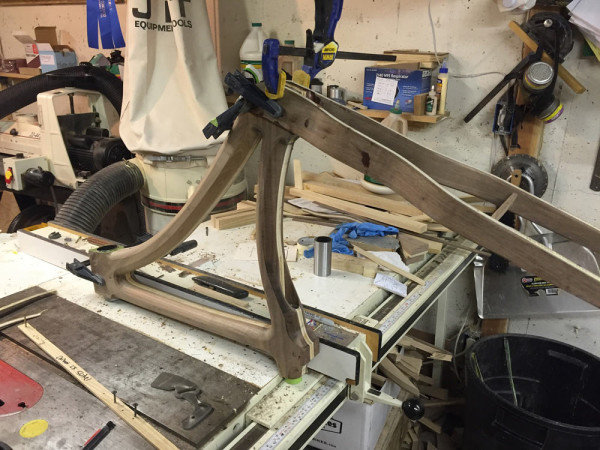
CHRIS: I’ve done a lot to “screw” with the ride quality. Basically, a lot of that came out of my original theories of what I wanted for a ride. I wanted good lateral rigidity, so it would track nice and straight and predictably, but I wanted to introduce a certain amount of suppleness to the ride. One of the great things about the wood is that it has a natural ability to suck up bumps and vibrations. That’s why wood is used in axle handles, hammer handles, and things like this. It’s always been a great natural material for soaking up bumps and shock. That’s where I wanted to capitalize on the ride quality of wood. I wanted it to perform like I wanted a bike to perform. I didn’t want it to be sloppy or have the feeling of a lot of flex in the frame while cornering, but I wanted it to have a suppleness to it that would in particular absorb shocks and smooth out the ride without being a soft tail or have any sort of real movement to it.
So what I did is set about building these big beefy chainstays. The chainstays are where I get a lot of my lateral rigidity. I have spaced out layers of wood with layers of composite materials between the wood, and then I have these curved seat stays. The curved seat stays add just a little bit of additional suppleness to the ride. So I’ve messed around with the level of reinforcement that I’ve put in the stays, and then I changed my woods recently. I’ve gone from using almost exclusively white ash to using black walnut, which is this sort of corresponding contrast color. Walnut and ash have different basic properties. Walnut is not quite as strong or as rigid as the ash.
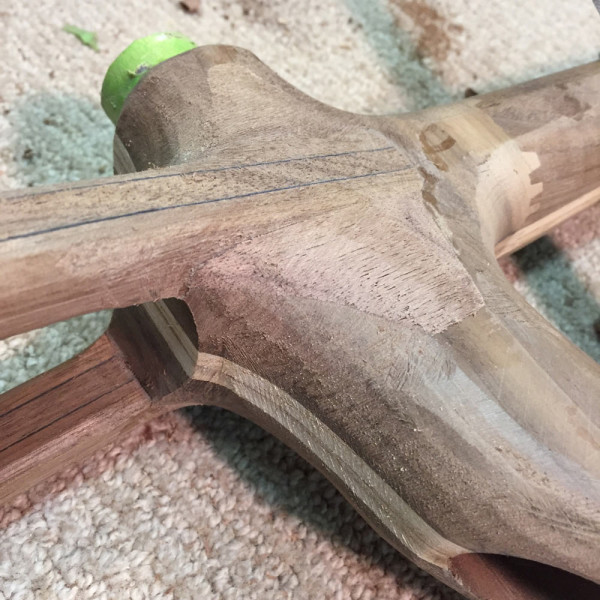
I reinforce things differently with the two different types of wood. I’m messed around with types of reinforcement in the Walnut bikes, I use a little more carbon fiber. In the ash bikes, I use a bit more Kevlar. The difference in some of the material properties between carbon fiber and kevlar, is that the carbon fiber increases the rigidity of things. With the walnut, it’s not quite as rigid or quite as stiff to begin with, so the carbon helps to beef it up a little bit. Whereas the ash already has some pretty good rigidity to it, and the Kevlar- what it does is that it increases the critical failure points because Kevlar is so incredibly strong that it has a little bit more inherent flex to it. So it lets the wood flex a little bit more, but increases the critical failure point to an exponential level. So I messed around with how much composite reinforcement that I was going to put into these things. The size of my chainstays in particular – and so I messed around with the size and the thickness of the chainstays trying to balance between rigidity, strength, and weight, and that’s kind of the critical combination in all of this stuff. You don’t want to have any more material than you need to, so I’ve been trying to cut my weight down. At the same time, I need to maintain strength and maintain ride quality. It’s been this kind of juggling act of trying not to under-build too much. But as I try to get lighter and lighter, I can go thinner and thinner. And I can introduce – in some areas where I add a little bit more composite to make up for less material for lower weight and the same sort of great ride quality that I’ve been shooting for. I don’t know if that get at what you meant by messing around.
BIKERUMOR: Yeah! It’s very enlightening. As someone who has spent a lot of time reading posts or looking at companies who do these wood concept bikes where they they toss out a design and go: okay! It looks like a bike. Then it’s like, well, what have you done with it? What does it mean? I feel like those one-off project bikes damage the material’s reputation more than anything. It’s disrespectful to the opportunity within the material.
Here, you’re treating wood like a composite material and you’re playing with the form and the laminate. People are riding Leadville on your bikes and having a blast.
CHRIS: Yeah, yeah. They’re doing real riding on it. And that’s what I wanted. I wanted something that was beautiful and functional, you could put it in your living room and look at it, or you could go ride Leadville on it.
BIKERUMOR: You sound excited about this stuff.
CHRIS: I am. I love it.
BIKERUMOR: Sometimes you have to ask builders – sometimes they don’t sparkle about it anymore.
CHRIS: The passion alone has to keep you doing this. But part of this that I still love about this is, there’s a little bit of magic in it everytime you get on one of the bikes. Maybe it’s just kind of defying logic, but when you get on it, it works, it’s a rush. This is maybe a side story, but a number of years ago, I rebuilt the engine in an old sports car that I have. Now, every time I turn the key and it fires right up, it’s like, wow! It works! And it thrills and excites me and amazes me, and it never gets old. When I get on one of my own bikes and I’m riding it, “It works! It’s awesome! I love it!” There’s this magic. Part of it is some people see the wood bikes and they immediately dismiss them. “It can’t work. It’s stupid. It’s going to be heavy. it’s going to break. Everyone knows everything that’s made out of wood breaks.”
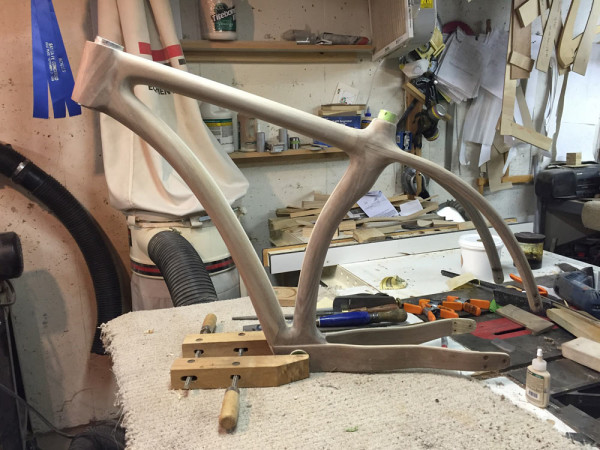
BIKERUMOR: Except for carpenters!
CHRIS: Except for carpenters. Except for people who know. People who work with wood or understand wood or have seen it used it used in amazing and innovative – not even innovative, but have seen how it can be used. But I think the general initial perception of wood is that it’s what’s used in your fence that goes around your yard. And it cracks after it’s been out in the rain. It’s like, that’s not structural wood. it’s something that’s abused and left out in the elements. It’s just a piece of wooden utility.
I don’t think people give wood a lot of credit, and I think their first reaction is that it’s impractical. It may not be the most practical solution because if you want a bike that’s the absolute lightest weight, yeah, you go carbon or titanium or things like that. If you want something that’s bombproof strength, steel or something like that. But the wood – it works. You can do everything you want with it. You get reasonable weight out of it – yeah, it’s a little bit heavier but not prohibitively so. Would I recommend it for a trials or downhill bike? No… probably not. But for cross country riding? For realistic riding, it can take the beating you’re going to throw at it. You’re going to break before you break one of these frames, and that’s what I’ve tried to prove in what I’m doing.
But of course, the initial reaction to a lot of people is they see craziness, the impracticality. One man’s impracticality is another man’s passion.
BIKERUMOR: That’s what I thought was so genius about the Louisville Slugger bike last year. That was brilliant! That’s a whole story about the impact resistance of the material. For some reason I guess I forgot that baseball bats were made out of wood – and then I went “Oh yeah! I get it!”
CHRIS: That was one of my early analogies for strength. I started out using White Ash. I was at a show somewhere talking about how strong wood is, the impact it will take. And the guy goes, “Just like a Louisville Slugger baseball bat.” I went “Yeah! Just like a Louisville Slugger baseball bat! That’s a great analogy!” So I use that analogy in talks. When I heard that NAHBS was going to be in Louisville last year, I called up some people at Slugger and pitched them my concept and they were like, “We love it!”
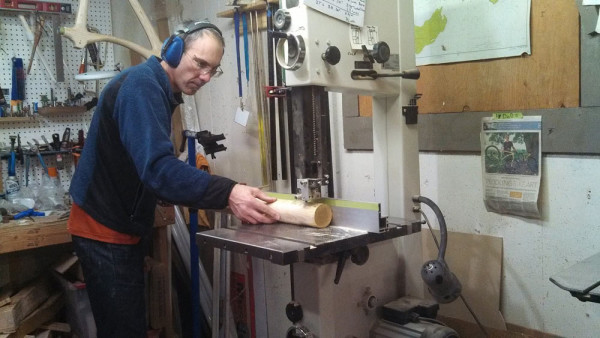
BIKERUMOR: For my personal curiosity – you’re selling bicycles, clearly. Someone is buying them. I personally want to jump on one and do a gravel century. I feel like it would be a wonderful material for that. So who is your typical customer? Who do you find is attracted to you as a builder because of your material?
CHRIS: It’s a variety of people. For the most part, it’s people that love bicycles for bicycling. They aren’t hardcore. They aren’t dedicated racers trying to shave weight. They are people who have four or five bikes. They have messed around with steel, titanium, and carbon. They are open-minded innovators and early adopters.
It’s people that are open to new possibilities. The inevitable look that you’re going to get: that’s a crazy idea… what are you doing riding a wood bike? They relish it. They relish the black sheep factor. They are willing to stand out and do something a little bit differently and appreciate it for what it is. It’s just a different experience. They are people who appreciate bicycles from an open-minded perspective, but they are also people who appreciate design and innovation.
They typically will have some connection to wood in their lives. For example, the guy that rode Leadville on my bikes, he’s an arborist. He works with trees, so he has this personal connection to wood. But other people, they always loved wood design, or wood boats, or have had some elements of appreciation for things that are beautiful and made of wood in their lives.
But the most common thing is that they are early adopters and not afraid of innovation and of doing things differently. That’s what this is. It’s not the mainstream and even as there are a number of other people that do wood bicycles and other natural materials, bamboo and stuff – they are still new. You ride down the street and they literally stop traffic. “Whoa! What is that?!” You have to be open to getting noticed, getting seen, drawing attention to yourself.
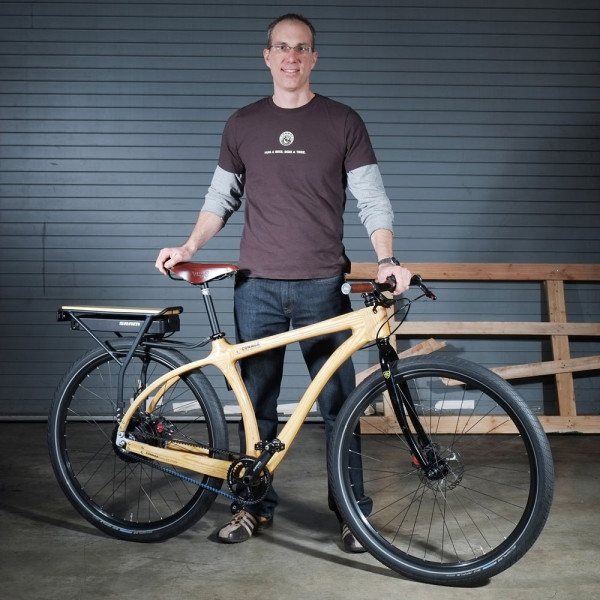
I’ve also had a number of corporate clients, like Louisville Slugger for example. People who are looking for essentially a mobile marketing way of showcasing their brand. Typically they will have a connection to wood products in some way. It’s an unusual work of functional art, and it gets attention. I’ve had a few companies now come to me and had me build them mobile marketing wood bikes.
BIKERUMOR: With that – what are you bringing to the show this year?
CHRIS: I’ve got four bikes lined up for the show this year. It’s a walnut frame cross bike, but it’s set up as a singlespeed with a Gates belt drive, disc brakes, and it’s running straight wood flat bars. It’s kind of a cool single speed townie bike but it’s built on a cross platform with bigger tires and a nice set of wheels on it.
Then I’m also bringing my new 27.5+ Mountain Cruiser. It’s a single speed belt drive, but it takes 27.5+ running a 2.8in WTB tires on the 50mm Scraper rim. High volume tire on the wood frame with a rigid carbon fork. It’s just a really bad ass, fun – you can do trails on it, you can cruise around town on it. High volume tires go on anything whether that’s snow, the dirt, the sand. Disc brakes, single speed, pure fun.
Then I’m bringing what I call the Super Scorcher, which is a version of my Scorcher townie bike, which has 29er wheels, the big 2.35in tires on it. I’m doing it in partnership with Cycle Monkey. It’s got a Rohloff SPEEDHUB 14 on it, Gates belt drive, a whole pack of Cycle Monkey Supernova lights on it. It has racks and panniers.
The fourth one I’m bringing is one of my gravel cross bikes, 1×11. Similar to one of the bikes that I brought last year, but this one’s in ash. It’s running a SRAM 1×11 drivetrain. It’s running a TRP hybrid mechanical disc brakes, some nice Rolf Prima wheels, and a Spot fork.
BIKERUMOR: That’s exciting. Are these all customer bikes?
CHRIS: Two of them are customer bikes. One’s a prototype and one’s a demo bike.
BIKERUMOR: So test rides aren’t completely out of the question…
CHRIS: The cross to gravel bike can be ridden, and the prototype bike, the mountain cruiser is ride-able too.
BIKERUMOR: To my final question: what do you tell the next Chris Connor? What do you tell the kid who wants to build wood bikes like you are now? What’s the advice you give that person?
CHRIS: There’s sort of a reality that you have to mix with your optimism. It’s not easy. And there are probably a hundred other things you could do that are going to be easier and will make you more money.
The message that I would have to give somebody is that you can do it if you put yourself to it and you throw all of yourself into it and you focus your energies on it. You can absolutely make something like this happen, and the reward is worth it if you love the challenge. If you want something easy, presumably, you’re not after the challenge and the challenge won’t be rewarding. But if you love the challenge and the satisfaction of always being challenged, trying to do things differently, having to think and make decisions, this is an incredibly rewarding way of building a career. But make no mistake about it, it isn’t easy.
